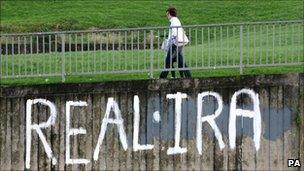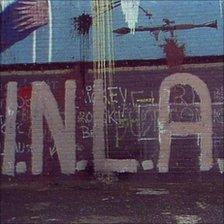Who are the dissident republicans?
- Published
BBC News examines the various dissident republican groups operating in Northern Ireland.
Real IRA
The Real IRA was born out of a split in the mainstream Provisional IRA (PIRA) in October 1997, when the PIRA's so-called quartermaster-general resigned over Sinn Fein's embrace of the peace process.

Shortly after its formation, the paramilitary group quickly took over from the older Continuity IRA as the leading home for dissidents.
However, the security forces believe the two organisations have co-operated in a number of attacks.
The Real IRA was responsible for the Omagh bombing in August 1998. It was also behind a string of subsequent attacks including the car bombing of BBC Television Centre in west London in June 2001 and the shooting of two soldiers at Massereene army base in 2009.
According to the Independent Monitoring Commission (IMC), the Real IRA and Continuity IRA are increasingly working more closely together to increase the threat posed to security forces.
The Real IRA is thought to be split into two fairly distinct factions, each with its own leadership structures.
Continuity IRA
The Continuity IRA (CIRA) has its origins in a split in the IRA which centred around opposition to republican candidates taking seats in the Irish Republic's parliament.

In 1986 some members of Sinn Fein, angry at the party's decision to end its policy of abstention broke away and formed a new party called Republican Sinn Fein.
The security forces say the CIRA was set up as the military wing of Republican Sinn Fein, although the party says that is not the case.
For many year the CIRA was a very small and largely inactive group. It announced its reappearance in 1996 when it destroyed a hotel in County Fermanagh with a bomb thought to contain more than 1,200lbs of explosives.
It is believed most of its members are concentrated in Counties Fermanagh and Armagh.
It claimed responsibility for the murder of police officer Stephen Carroll in March 2009.
Recently the Continuity IRA is believed to have split between those on the traditional wing - mainly members in the Irish Republic - and a younger faction based mainly in Northern Ireland.
Oglaigh na hEireann
The name Oglaigh na hEireann (which roughly translates as soldiers of Ireland) has been used by a variety of groups.
It is the sole name used by a relatively new group which has been the most active dissident republican organisation over the past year.
It comprises a small group of veteran members of other paramilitary organisations, including the Provisional IRA.
The group, which emerged around 2005, is mainly based in Belfast and South Armagh, but has shown itself capable of carrying out attacks over a wide geographical area.
Earlier this year, a Catholic police officer was left critically injured when an Oglaigh na hEireann bomb exploded underneath his car in County Antrim.
Its attack in summer 2010 have included the attempted booby-trap bombing of an Army major in County Down and a bomb attack on Strand Road police station in Derry.
In an interview with the Irish News in August 2010, the organisation said the "vast majority" of its members are former Provisional IRA men.
A spokesperson said they had been prepared to give Sinn Fein an opportunity to show that politics could be a substitute for violent action but had lost patience with the strategy.
He said that popular support for armed struggle was irrelevant and that Oglaigh na hEireann would only hold talks with the British government if it was likely that they would lead to British withdrawal within a short timeframe.
Other groups which have used the title Oglaigh na hEireann include a faction which split from the Continuity IRA in 2006 and a Real IRA splinter group.
Coincidentally, Oglaigh na hEireann is also the official Irish-language title for the Irish defence forces.
Irish National Liberation Army

The Irish National Liberation Army was formed in 1975, mainly from disaffected members of the IRA unhappy at a previous ceasefire. It has killed more than 150 people.
Its most high profile murder was that of Loyalist Volunteer Force leader Billy Wright, who was shot dead in the Maze prison in 1997.
The INLA regularly indulged in bouts of bloody in-fighting and became involved in organised crime, such as extortion and robbery.
It claimed responsibility for the murder of a drug dealer in Londonderry in February, but was considered to be the least active of the dissident groups in recent years.
On 11 October 2009, the INLA announced that its armed struggle was over and said its objective of a "32-county socialist republic" would be best achieved through exclusively peaceful means.
Republican Action Against Drugs
Republican Action Against Drugs (RAAD) is an organisation widely believed to be made up of former IRA members.
Some believe it may be a front for other dissident groups.
According to the Independent Monitoring Commission RAAD is partly responsible for the increase in paramilitary-style attacks in Londonderry.
The group have claimed responsibility for about 12 "punishment shootings" in the city over the past year, including attacks on suspected drug dealers.
In its report from November 2009, the IMC referred to the "growth of vigilante organisations which claim to want to 'clean-up' anti-social behaviour".
The IMC said these groups were "a factor behind the increase in the number of attacks in some nationalist areas".